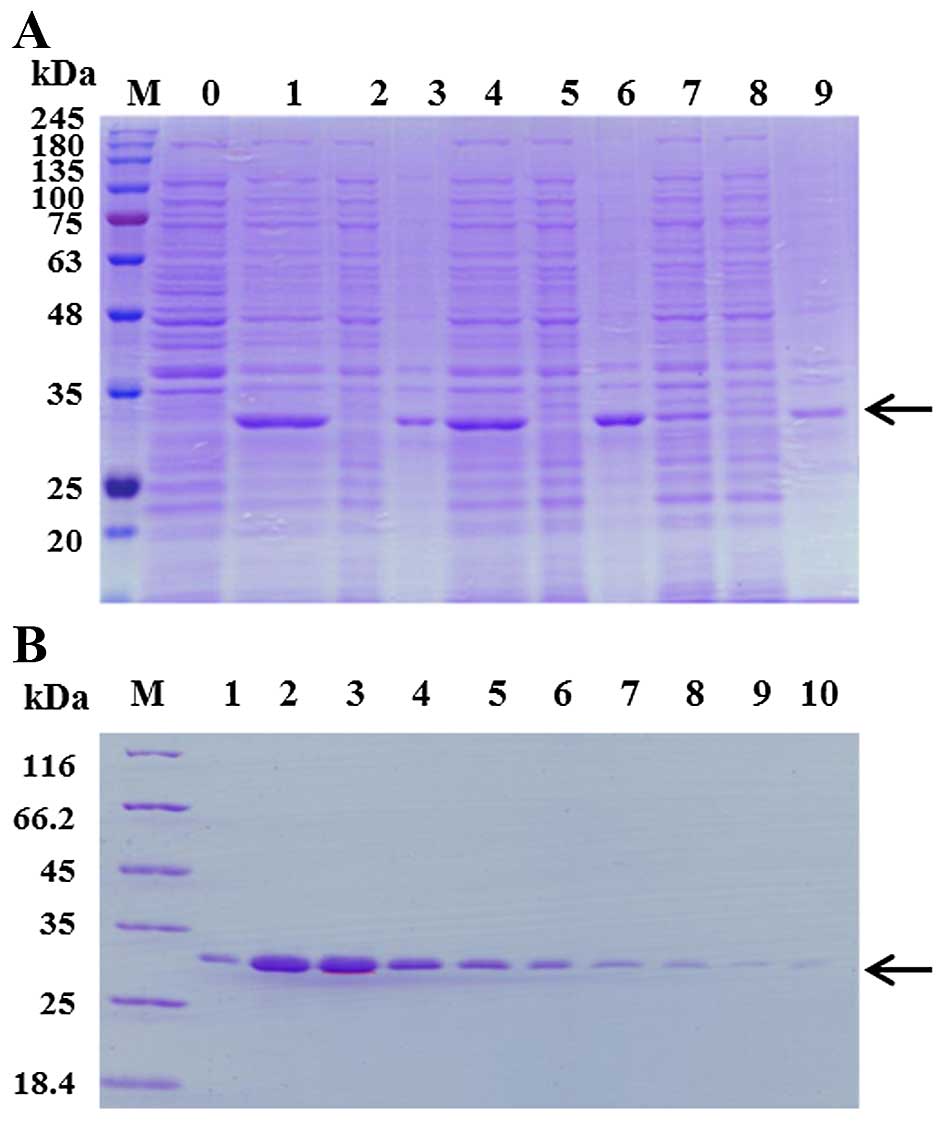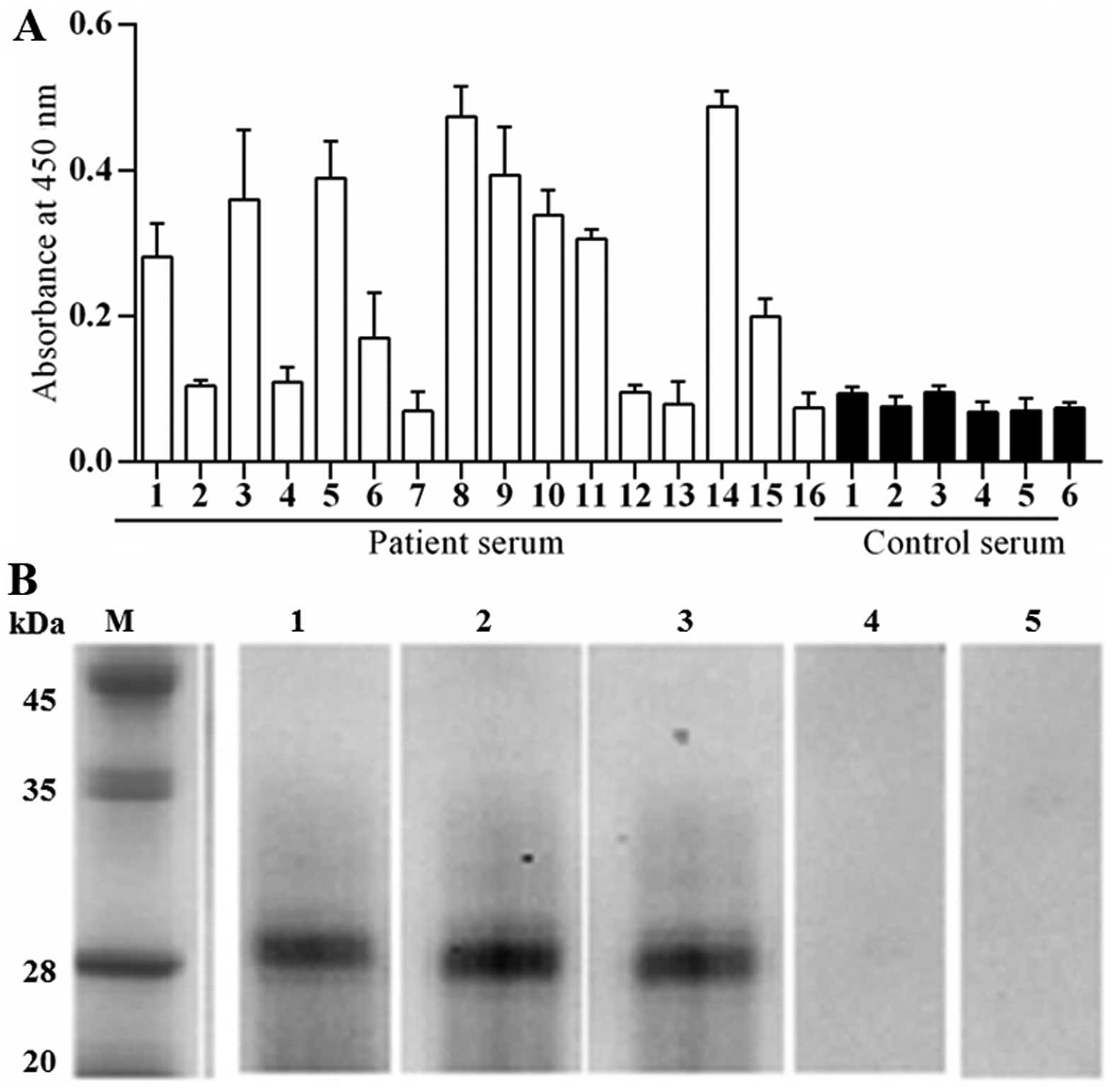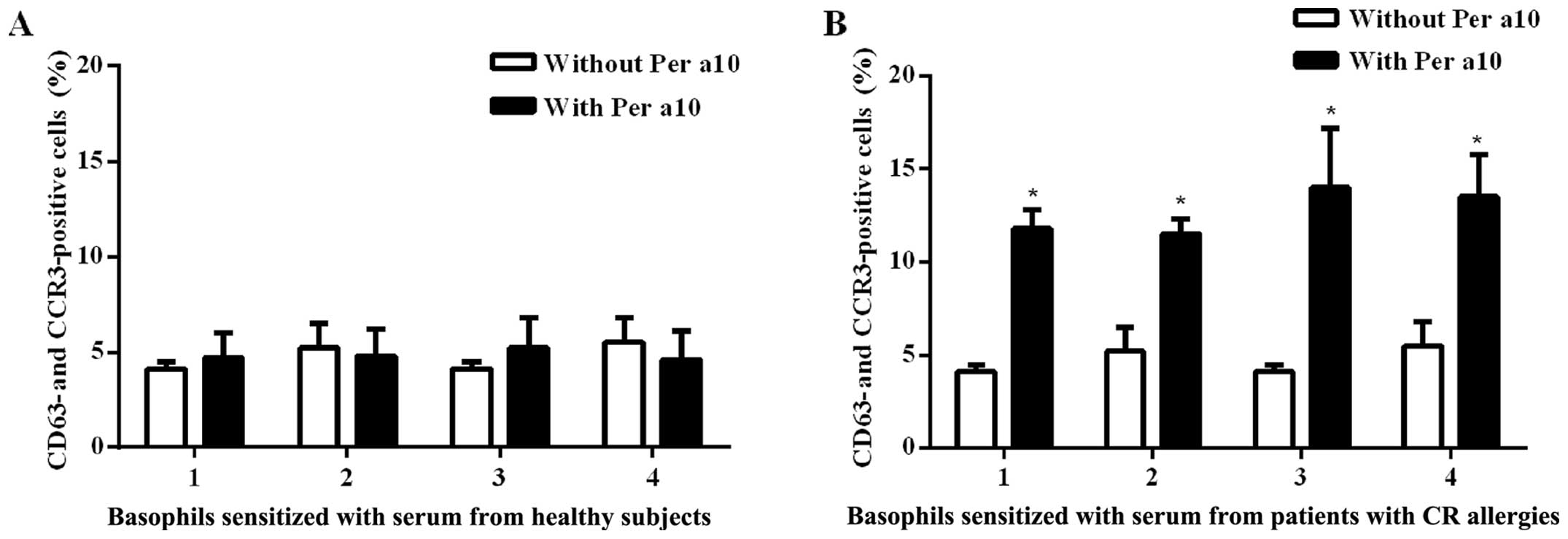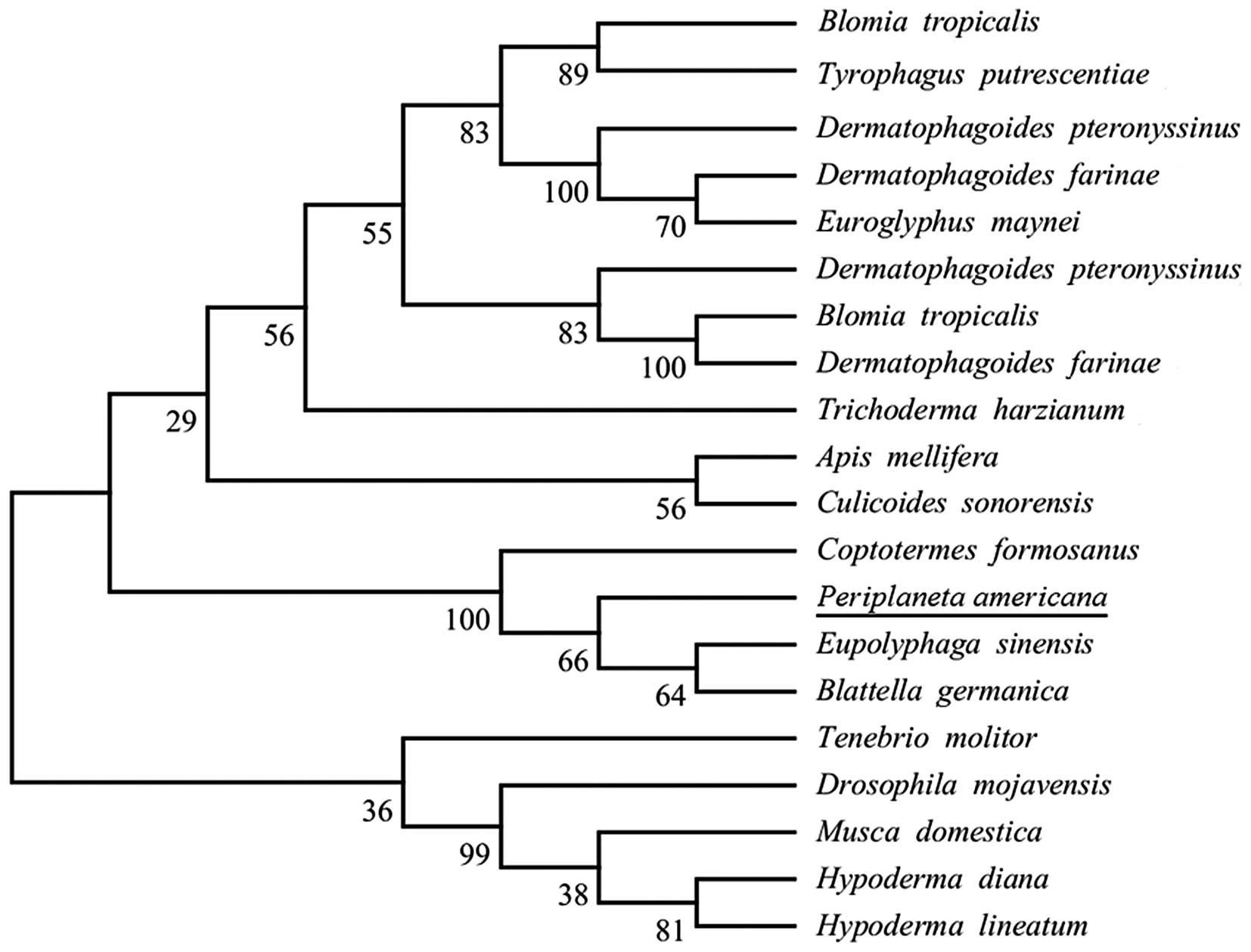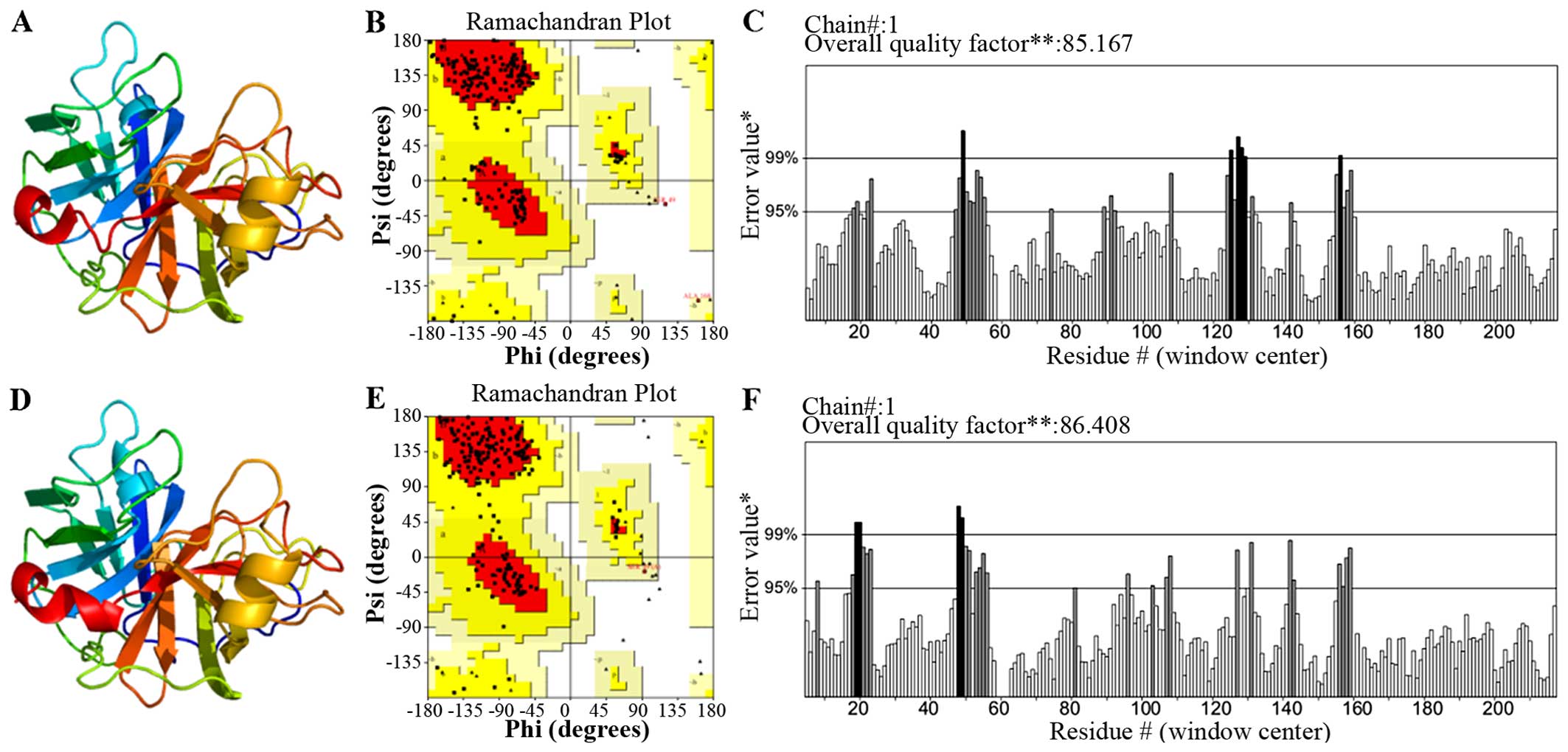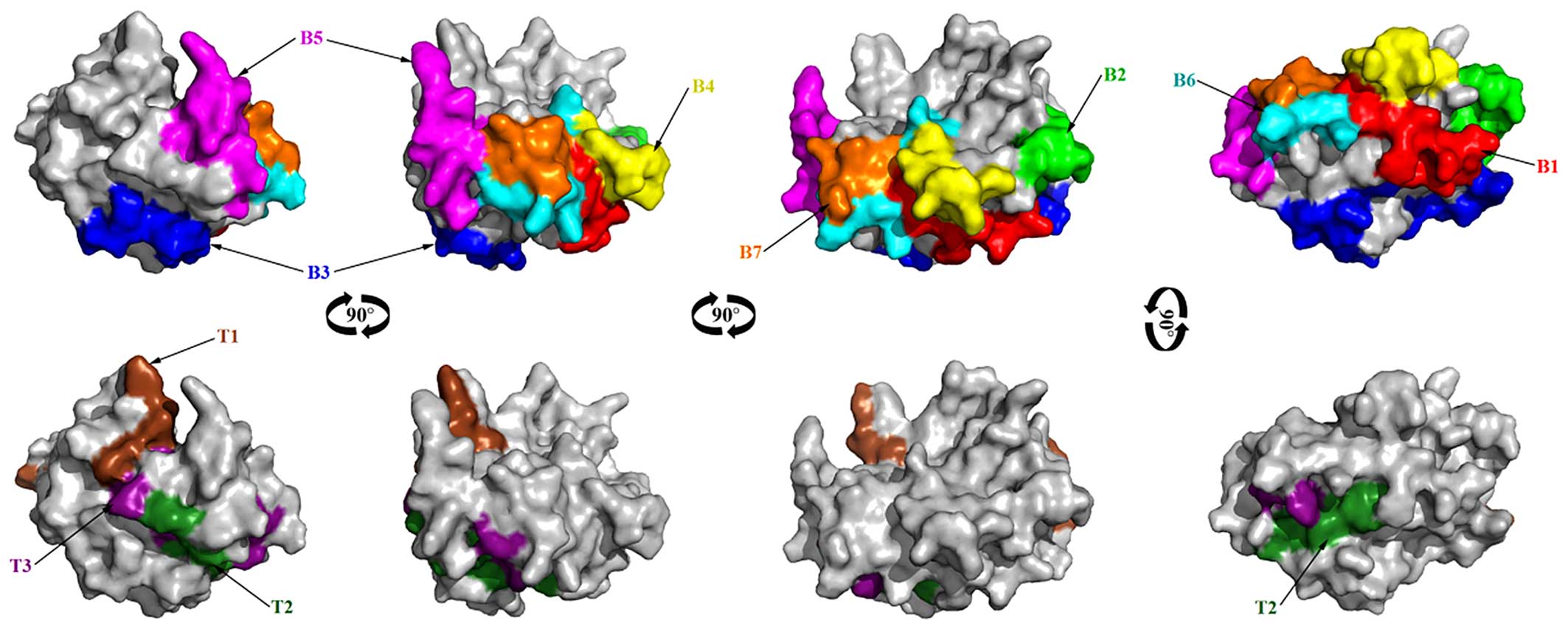In silico epitope prediction, expression and functional analysis of Per a 10 allergen from the American cockroach
- Authors:
- Published online on: October 26, 2016 https://doi.org/10.3892/ijmm.2016.2790
- Pages: 1806-1814
-
Copyright: © Tong et al. This is an open access article distributed under the terms of Creative Commons Attribution License.
Abstract
Introduction
A number of individuals worlwide are known to suffer from cockroach (CR) allergies and the CR allergies are considered to play an important role in IgE-mediated type I hypersensitivity since 1964 (1). German CR [Blattella germanica (Bla g)], American CR [Periplaneta Americana (Per a)] and smoky brown CR (Periplaneta fuliginosa) are the main species which are known to cause allergies worldwide (2). In China, a number of patients with allergies are found to positive for CR allergens in the skin prick test (SPT); 25.7% are shown to be positive for the American CR and 18.7% are shown to be positive for the German CR (3).
The adult American CR has 22 IgE binding components with pooled sera from patients, including the proteins of 23, 28, 35, 38, 40, 49, 72, 78 and 97 kDa as major allergens (4). Some of these allergens namely, Per a 1 (5), Per a 2 (previously known as Cr PI) (6), Per a 3 (7), Per a 4 (8), Per a 5 (9), Per a 6 (10), Per a 7 (11), Per a 9 (previously known as Periplaneta americana arginine kinase) (12,13), Per a 10 (14), Per a 11 (15) and Per a 12 (15) have been characterized. Among these allergens, Per a 10 was isolated from American CR extract using a benzamidine sepharose column and characterized by immunobiochemical methods. It is a serine proteinase with a molecular weight of approximately 28 kDa (14). Per a 10 was recognized as a major allergen, showing IgE reactivity with >80% of cockroach sensitized patients by skin tests and immunoblot (14). Further studies found that Per a 10 can modulate CD40 expression on the dendritic cell surface through the nuclear factor-κB (NF-κB) pathway (16) and can promote the dendritic cell type 2 phenotype via the upregulation of CD86, increased high interleukin-6 (IL-6) secretion and reduced IL-12 secretions (17).
Recent studies have suggested that CR immunotherapy may be a promising treatment strategy with immunomodulatory and clinical effects (18,19). However, patients with CR allergies often exhibit complex sensitization patterns to multiple CR-associated proteins and an immunodominant allergen has not yet been identified (20). To realize the full potential of this treatment modality, further investigations of CR allergens are warranted. The identification of B cell epitopes (IgE-binding epitopes) of an allergen is helpful in designing sequences for more accurate and safer peptide-based allergen diagnosis and immunotherapeutic agents. The IgE-binding epitopes of Per a 1 (21), Per a 2 (22), Per a 3 (23), Per a 4 (8) and Per a 6 (10) have previously been identified by experimental or bioinformatics methods. T cell epitopes have been successfully identified based on computer simulation over the past decade. Extracellular peptides have to bind to major histocompatibility complex (MHC) class II to stimulate T lymphocyte responses. Thus, T cell epitopes have been predicted indirectly by the identification of MHC-binding molecules (20). In a previous study (13), using in silico analysis, we performed epitope prediction and functional analysis of the Per a 9 allergen from the American CR. In the present study, in continuation of our investigation on Amiercan CR allerens, we firstly cloned, expressed the American CR major allergen Per a 10 and identified the B and T cell epitopes of the Per a 10 allergen using an in silico approach. Our findings suggest the potential utility of these allergens and epitopes in the development of peptide-based vaccines for the prevention and/or treatment of CR allergies.
Materials and methods
Patients and samples
As in our previous study (13), in this study, 16 patients with allergic rhinitis who were found to have positive SPT results and positive results for the serum IgE test for the American CR extract (by using ImmunoCAP assay; Pharmacia Diagnostics AB, Uppsala, Sweden) and 6 healthy controls (HC) who showed negative results for the serum IgE test were recruited. Blood samples were obtained from all participants after obtaining written informed consent and this study was approved by the Ethics Committee of the First Affiliated Hospital of Nanjing Medical University, Nanjing, China.
Molecular cloning of the American CR Per a 10 gene
Total RNA was isolated from female CRs using TRIzol reagent (Invitrogen, Carlsbad, CA, USA). Total RNA was quantified by measuring the absorbance ratios at 260/280 nm. Total RNA was reverse transcribed into cDNA using oligo(dT) by reverse transcriptase using a commercial cDNA synthesis kit according to the manufacturer's instructions (Takara Biotech Co., Dalian, China). The gene encoding Per a 10 was amplified by PCR using primers based on the nucleotides sequence of the Per a 10 gene (AY792954.1; forward, 5′-ATGC TTCGCTACCTGGTACTT-3′ and reverse, 5′-TTAGTTGACTCCAGTCTGTTC-3′). The PCR conditions were as follows: 98°C/5 min (1 cycle), 98°C/10 sec, 50°C/15 sec and 72°C/1 min (35 cycles), and 72°C/5 min (1 cycle). The purified PCR product was cloned into the pMD18-T vector (Takara Biotech Co.) and transformed into the Escherichia coli (E. coli) strain DH5α. The inserts were confirmed by DNA sequencing.
Expression and purification of Per a 10 in E. coli
As previously described with some modifications (13), the Per a 10 gene was subcloned into the pET-22b(+) vector (Novagen, Madison, WI, USA) using the NdeI and XhoI sites and confirmed by DNA sequencing. The recombinant pET22b(+)-Per a 10 plasmid was transformed into the Rosette-gami E. coli host strain. The selected pET22b(+)-Per a 10-transformed Rosette-gami E. coli was inoculated into 5 ml of LB-ampicillin broth, and incubated at 37°C overnight. Five milliliters of the culture were inoculated into 500 ml of fresh LB-ampicillin broth and incubated at 28°C while shaking at 200 rpm until the optical density (OD) at A600nm reached 0.5. Isopropyl-β-D-thiogalactopyranoside (IPTG) was added to a final concentration of 1 mM and the culture was incubated for a further 7 h. The bacterial cells were harvested by centrifugation at 4,000 × g at 4°C for 20 min, and were lysed in lysis buffer by sonication at 20 kHz, 2 min pulse-on, 3 min pulse-off. The recombinant Per a 10 was mainly contained in inclusion bodies. The inclusion bodies were collected by centrifugation at 12,000 × g at 4°C for 20 min. Following solubilization of the inclusion bodies by 6 M urea, the supernatant was loaded onto a Nickel column (Genscript, Nanjing, China), washed with running buffer containing 50 mM Tris-HCl, 300 mM NaCl (pH 8.0), and eluted with elution buffer containing 50 mM Tris-HCl, 300 mM NaCl, 250 mM imidazole. The eluted fractions were collected and dialyzed with 6-4-2-1-0.5-0 M urea, each for 2 h.
Immunoreactivity of recombinant Per a 10 with serum from patients with CR allergies
A 96-well plate was coated with recombinant 100 μl Per a 10 (10 μg/ml) in carbonate-bicarbonate buffer (0.05 M, pH 9.6) overnight at 4°C. Human serum samples (1:20 dilution in PBS-Tween-20 with 2% BSA) were then added to the plates and incubated for 2 h at room temperature. Following IgE binding, the plates were incubated with horseradish peroxidase-labeled goat anti-human IgE (1:2,500 dilution) (KPL, Inc., Gaithersburg, MD, USA), and the color was developed with tetramethylbenzidine (TMB) peroxidase substrate. The plates were read on a microplate reader (Eon; BioTek, Winooski, Vermont, USA) at an absorbance of 405 nm. The cut-off value of the enzyme-linked immunosorbent assay (ELISA) was calculated as the mean of the negative controls plus 2 SDs, as previously described (9).
Immunoblot analysis of the IgE reactivity of Per a 10
Immunoblots for the detection of IgE reactivity of Per a 10 were performed as described previously (24,25). Per a 10 (5 μg) was conducted to a sodium dodecyl sulfate-polyacrylamide gel electrophoresis (SDS-PAGE; gel concentration of 15%) under reduced conditions and then transferred onto nitrocellulose membranes. The nitrocellulose membranes were firstly incubated with sera from patients with American CR allergies (1:5 to 1:20 in PBS-Tween-20 with 1% BSA, 10% normal goat serum) for 90 min, and then incubated with peroxidase-labeled anti-human IgE monoclonal antibody (074-1004, KPL, Inc., Gaithersburg, MD, USA). The positive protein bands were visualized by incubating the membranes with TMB peroxidase substrate. Sera from 2 non-allergic healthy subjects were used as the negative controls.
Basophil activation test
The expression of CD63 and CCR3 on the basophil surface is considered as an indicator of basophil activation (26,27). Briefly, and as previously described (13), peripheral blood mononucleated cells (PBMCs) from 4 healthy volunteers were separated by Ficoll-Paque density gradient, and treated with 10 ml LS solution (1.3 M NaCl, 0.005 M KCl and 0.01 lactic acid, pH 3.9) for 2 min at 8°C. Following neutralization with 12% Tris (pH 10.9), non-specific IgE on basophils was stripped off. Subsequently, the basophils were passively sensitized with the sera of patients with American CR allergies or from the healthy non-allergic healthy controls (n=4, 1 in 10 dilution, 2 h at 37°C) (same patients and controls as described above) as previously described (23). The sensitized basophils were challenged with Per a 10 (1.0 μg/ml) for 15 min at 37°C. CCR3-PE-labelled antibody (85-12-1939-42; eBioscience Inc., San Diego, CA, USA) and anti-human CD63-FITC antibody (HH-MHCD63014; Invitrogen, Camarillo, CA, USA) were added to cells for 15 min at 37°C. Flow cytometric analysis of CD63 and CCR3 was performed at 488 nm on a FACSAria flow cytometer (Becton-Dickinson, Franklin Lakes, NJ, USA) and analyzed by FACSDiva software.
Sequence retrieval Per a 10 homolog and phylogenetic analysis
The complete amino acid sequence of Per a 10 was used as query to search for homologous sequences by tBLASTn in NCBI (blast.ncbi.nlm.nih.gov/Blast.cgi) (10,28–30). The phylogenetic tree of Per a 10 and its homolog was obtained by the maximum-likelihood (ML) method on the basis of the JTT amino acid sequence distance implemented in MEGA 5.1, the reliability was evaluated by the bootstrap method with 1,000 replications (28–32).
Physiochemical analysis and post-translational patterns and motifs of Per a 10
As previously described (13), physiochemical analysis, including molecular weight, theoretical pI, amino acid composition, instability index, aliphatic index and the grand average of hydropathicity (GRAVY) of Per a 10 was performed using the ProtParam tool (http://web.expasy.org/protparam/) (33).
Secondary structure prediction of Per a 10
As previously described (13), the secondary structure of Per a 10 was assessed by PSIPRED (bioinf.cs.ucl.ac.uk/psipred) (34) and NetSurfP ver. 1.1 (www.cbs.dtu.dk) (35).
Homology modeling and validation
As previously described (13), the best homologous templates for Per a 10 were selected using the PSI-BLAST server (http://blast.ncbi.nlm.nih.gov/Blast.cgi) in NCBI and Swiss-model server (http://swissmodel.expasy.org/) and used for homology modeling. The modeled protein structure of Per a 10 was built by SWISS-MODEL (http://swissmodel.expasy.org/). An initial structural model was generated and checked for recognition of errors in 3D structure by PROCHECK (36), ERRAT (verification of protein structures: patterns of nonbonded atomic interactions) (33,37) and VERIFY_3D (a method to identify protein sequences that fold into a known three-dimensional structure. Assessment of protein models with 3-dimensional profiles) programs in Structural Analysis and Verification Server (http://nihserver.mbi.ucla.edu/SAVES/) (33,37).
In silico prediction of B cell epitopes of Per a 10
As previously described (13), 3 immunoinformatics tools, namely the DNAStar Protean system (38), bioinformatics predicted antigenic peptides (BPAP) system (http://imed.med.ucm.es/Tools/antigenic.pl) and the BepiPred 1.0 server (http://www.cbs.dtu.dk/services/BepiPred/) were used to predict the B cell epitopes of Per a 10 (39,40). The ultimate consensus epitope results were obtained by combining the results of the 3 tools (41). If the results of all 3 methods were non-epitope, the consensus result was then considered 0% epitope. Similarly, if the predicted results had only one or no non-epitope, the consensus result was considered 67 or 100% epitope, respectively. Finally, the regions whose consensus epitope result was 67 or 100% were chosen as the final potential epitope regions.
In silico prediction of T cell epitopes
As previously described (13), for HLA-DR-based T cell epitope prediction, the artificial neural network-based alignment (NN-align) method NetMHCIIpan-3.0 (http://www.cbs.dtu.dk/services/NetMHCIIpan/) was applied (42). We used HLA-DR 101, HLA-DR 301, HLA-DR 401 and HLA-DR 501. The ultimate HLA-DR-based T cell epitope results were obtained by combining those 4 results together that if 3 of them showed epitope, and then the consensus result was epitope. For HLA-DQ alleles, NetMHCII-2.2 (http://www.cbs.dtu.dk/services/NetMHCII/) was used (43). We only used HLA-DQA10501-DQB10201, HLA-DQA10301-DQB10302, HLA-DQA10401-DQB10402, and HLA-DQA10102-DQB10602. As a result, the ultimate consensus epitope results were obtained by combining the results of the HLA-DR-based T cell epitope and HLA-DQ-based T cell epitope. B cell and T cell epitopes identified by computational tools were mapped onto linear sequence and on the three dimensional model of Per a 10 to determine their position and secondary structure elements involved.
Statistical analysis
Data are expressed as the means ± SE for the indicated number of independently performed duplicated experiments. Statistical significance between means was analyzed by one-way ANOVA or the Student's t-test utilizing the SPSS 13.0 version. A valoue of P<0.05 was considered to indicate a statistically significant difference.
Results
Molecular cloning of the Per a 10 allergen of the American CR
The cDNA encoding the Per a 10 gene was amplified by PCR. It is 771 bp gene and encodes a 256 amino acids protein. The sequence homology with the published one (Accession no. AY792954.1) was 100% (256/256) at the protein level. Among the 256 amino acid protein, MLRYLVLASLIACSLS is a signal peptide, and AVPKAKRPRLDGR is a pro-peptide, which would be removed in the mature Per a 10. So the mature Per a 10 contained 227 amino acids.
Expression and purification of Per a 10 in E. coli
The American CR allergen Per a 10 was subcloned into the pET-22b(+) vector and transformed into the Rosette-gami E. coli host strain. Per a 10 was firstly expressed at temperatures of 16°C, 28°C or 37°C (Fig. 1A). It was found that Per a 10 was expressed mainly in the inclusion body and 28°C was the optimal temperature condition for its expression. Thus, the condition of 1 mM IPTG and a temperature of 28°C was selected for the large expression and purification of Per a 10. The dissolved Per a 10 inclusion body was purified by a Ni column. After the successful renaturation of purified Per a 10, approximately 1.4 mg recombinant Per a 10 was obtained from 500 ml of cell culture. The purity of the purified Per a 10 was identified by SDS-PAGE. It showed a single band with an apparent molecular weight of 30 kDa (Fig. 1B).
Immuno-reactivity of Per a 10 to IgE
In order to determine the allergenicity of Per a 10, the ability of Per a 10 to bind IgE in sera from patients with American CR allergies was determined by a direct ELISA technique. The sera from patients 1, 3, 5, 6, 8, 9, 11, 14 and 15 showed positive IgE reactivity to Per a 10. The results revealed that 9 out of 16 (56.3%) of the sera from these patients reacted to Per a 10 (Fig. 2A). The IgE binding activity of Per a 10 in a representative group of 3 patients and 2 healthy controls was assessed by western blot analysis and the results are illustrated in Fig. 2B.
Per a 10 induces human basophil activation
Per a 10 at 1.0 μg/ml induced an approximately 2.3-fold increase in the number of CD63 and CCR3 double-positive cells following incubation with passively sensitized basophils from the sera of patients with American CR allergies. We found that Per a 10 had no effect on the basophils sensitized by the sera from the healthy controls (Fig. 3). These results are similar to those of our previous study on the Per a 9 American CR allergen, where we had also found that thye basophils sensitized by the sera from the healthy controls were not affected, whereas the basophils sensitized by sera from the allergic patients exhibited a 4.2-fold increase in the number of CD63 and CCR3 double-positive cells (13).
Sequence retrieval and phylogenetic analysis
Uniprot and tBLASTn were used to search the homologous sequences of Per a 10. As a result, 20 sequences were obtained. Moreover, the results of phylogenetic analysis of Per a 10 and its homologous sequences inferred by the ML method are shown in Fig. 4.
Physiochemical analyses of Per a 10
The primary structure of Per a 10 contained 227 amino acids and the molecular weight was 23295.6. The theoretical pI was 4.28 and the aliphatic index was 76.04. The GRAVY was 0.001, indicting that Per a 10 exhibited a hydrophilic character. The instability index was 34.61 (<40), indicating that the Per a 10 protein was stable.
Structural analysis of Per a 10
Secondary structure prediction with PSIPRED identified 2 α-helices and 14 β-sheets in Per a 10. PredictProtein predicted 2 α-helices and 12 β-sheets. Moreover, NetSurfP v1.1 also predicted 2 α-helices and 12 β-sheets. In total, all secondary structure prediction yielded the same results: the secondary structure of Per a 10 contained 2 α-helices and 14 β-sheets and the results are presented in Table I.
Homology modeling and validation of Per a 10
The search for the proteins Per a 10 with a known tertiary structure in the PDB yielded pacific salmon anionic Trypsin (PDB Accession no. 1MBQ; https://www.ncbi.nlm.nih.gov/Structure/mmdb/mmdbsrv.cgi?uid=1MBQ) showing the highest sequence identity (44% with Per a 10). As a result, the 1MBQ template was used for homology modeling. The tertiary structure of Per a 10 constructed by the homology model is shown in Fig. 5A. As indicated by the Ramachandran plot (Fig. 5B), 81.9% of the residues in the model structure were within the most favored regions, 17.5% of the residues were in the allowed region, and 0.6% of the residues were in the disallowed region. As indicated by the ERRAT program, the results (Fig. 5C) revealed that the overall quality factor was 85.167, which indicated that the structure had a relatively high resolution. As indicated by the VERIFY_3D program, the results revealed that 90.54% of the residues had an average 3D (atomic model)-1D (amino acid sequence) score of >0.2, which is not sufficient. Thus, we optimized this modeled structure by Chiron (http://troll.med.unc.edu/chiron/login.php). The optimized Per a 10 structure is shown in Fig. 6D. The results of the Ramachandran plot revealed that 79.7% of the residues in the model structure were within the most favored regions, 20.3% of the residues were in the allowed region, and 0% of the residues were in the disallowed region (Fig. 5D). As indicated by the ERRAT program, the result (Fig. 5E) showed that the overall quality factor is 86.408 which mean the structure has a relatively high resolution. As indicated by the VERIFY_3D program (Fig. 5F), the results indicated that 94.14% of the residues had an average 3D (atomic model)-1D (amino acid sequence) score of >0.2, and this results was favourable. Based on these validations, the optimized Per a 10 structure was adopted for further analysis.
B cell epitope prediction of Per a 10
Bases on surface accessibility, fragment flexibility and hydrophobicity analysis of Per a 10, the final predicting regions of Per a 10 by DNAstar were obtained as: 2–10, 55–65, 109–115, 125–133, 147–160, 170–182, 201–208 and 223–227. The predicted results of the BPAP system were 8–20, 22–51, 63–74, 78–96, 98–110, 113–120, 132–147, 149–156, 162–168, 182–203 and 205–218. The predicted results of the BepiPred 1.0 server were 1–12, 46–67, 74–80, 95–134, 149–160, 169–186, 201–211 and 223–227. The ultimate results of the 3 immunoinformatics tools finally predicted 8 peptides (2–12, 55–67, 98–120, 125–133, 149–160, 170–182, 201–208 and 223–227) and these peptides are shown in Fig. 6.
T cell epitope prediction
For HLA-DR-based T cell epitope prediction of Per a 10, the final predicting regions of HLA-DR 101, HLA-DR 301, HLA-DR 401 and HLA-DR 501 are shown in Table II and the ultimate results of HLA-DR-based T cell epitope prediction finally predicted 2 peptides (83–91 and 139–147). For HLA-DQ alleles, the final results of HLA-DQA10101-DQB10501, HLA-DQA10301-DQB10302, HLA-DQA10401-DQB10402, and HLA-DQA10102-DQB10602 are also shown in Table II and the ultimate results of these 4 methods finally predicted 2 peptides, 84–92 and 162–170. As a result, Per a 10 was predicted to have 3 T cell epitope sequences, namely 83–92 (a combination of peptide 83–91 and 84–92), 139–147 and 162–170 as shown in Fig. 6.
Discussion
To better understand the Per a 10-mediated CR allergies and with an aim improve the diagnosis and treatment of CR allergies, we cloned and purified the American CR allergen, Per a 10, in an E. coli expression system. Per a 10 was a serine proteinase, isolated from American CR extract using a benzamidine sepharose column and characterized by immunobiochemical methods and represents a major American CR allergen, with IgE reactivity to 80% of sera from patients with CR allergies, as shown by skin tests and immunoblot analysis (14).
Our results showing that 9 out of 16 (56.3%) of sera from patients with CR allergies react to Per a 10, confirmed that Per a 10 is a major allergen of the American CR. It has <80% IgE reactivity in the Thai population (14). In this study, we confirmed the IgE reactivity of Per a 10 by a basophil activation test, which is a more advanced technique for the determination of allerginicity of allergens. It was found that Per a 10 is an active allergen of the American CR and that it is able to activate basophils which are sensitized by sera from patients with American CR allergies. The availability of recombinant allergens has increased our understanding of IgE-mediated allergies and may help to improve the diagnosis and treatment of these diseases (44). In our case, recombinant Per a 10 may be used for the further functional and clinical analysis.
Allergen-specific IgE is the key molecule for the development of allergic symptoms. The identification of B cell epitopes (IgE-binding epitopes) of an allergen is valuable for the accurate and safer peptide-based allergen diagnosis and immunotherapeutic agents. The in silico prediction of B cell epitopes has already become a useful tool for selecting B cell epitopes from immunological relevant proteins (45) and correlates well with the experimental approach (46). Many algorithms have been developed to predict B cell epitopes on a protein sequence based on the propensity values of amino acid properties of hydrophilicity, antigenicity, segmental mobility, flexibility and accessibility (47). In the present study, we predicted the B cell linear epitopes of Per a 10 allergens by the 3 sequence-based tools (DNAStar protean system, BPAP and BepiPred 1.0 server) and predicted 8 peptides (2–12, 55–67, 98–120, 125–133, 149–160, 170–182, 201–208 and 223–227) as potential B cell linear epitopes.
T cell epitopes are principally predicted indirectly by identifying the binding of peptide fragments to the MHC complexes. However, the binding grooves of MCH-II molecules are open at both ends, allowing various lengths of peptides to bind. On the other hand, the same MHC molecule can accommodate a variety of binding sequences. These two properties make the development of accurate predictive algorithms for MHC-class II binding complicated (40). Some algorithms have substantially improved their accuracy to predict T cell epitopes of immunological relevant proteins. However, most algorithms target HLA-DR molecules, but not HLA-DP and HLA-DQ molecules, even though they are important for antigen presentation. In this study, NetMHCIIpan-3.0 was applied for HLA-DR-based T cell epitope prediction of Per a 10 and finally predicted 2 peptides (83–91 and 139–147).
NetMHCII-2.2 was used for HLA-DQ-based T cell epitope prediction of Per a 10 and predicted 3 T cell epitope sequences, including 84–92, 139–147 and 162–170. As a result, the ultimate consensus epitope results were obtained by combining the results of the HLA-DR-based T cell epitope and HLA-DQ-based T cell epitope. As a result, Per a 10 was predicted to have 3 T cell epitope sequences, namely 83–92, 139–147 and 162–170.
Acknowledgments
This study was sponsored by grants from the Special Fund for Forestry-Scientific Research in the Public Interest (no. 201304103), grants from the National Natural Science Foundation of China (nos. 81571568, 81400037, 31340073 and 81273274); Jiangsu Province's Key Provincial Talents Program (no. RC201170); the Priority Academic Program Development of Jiangsu Higher Education Institutions (PAPD); the Six Talents Peak projects of Jiangsu Province (to J.-F.W.).
References
|
Bernton HS and Brown H: Insect allergy preliminary studies of the cockroach. J Allergy. 35:506–513. 1964. View Article : Google Scholar : PubMed/NCBI | |
|
Arruda LK, Vailes LD, Ferriani VPL, Santos AB, Pomés A and Chapman MD: Cockroach allergens and asthma. J Allergy Clin Immunol. 107:419–428. 2001. View Article : Google Scholar : PubMed/NCBI | |
|
Sun BQ, Lai XX, Gjesing B, Spangfort MD and Zhong NS: Prevalence of sensitivity to cockroach allergens and IgE cross-reactivity between cockroach and house dust mite allergens in Chinese patients with allergic rhinitis and asthma. Chin Med J (Engl). 123:3540–3544. 2010. | |
|
Thangam Sudha V, Arora N, Sridhara S, Gaur SN and Singh BP: Biopotency and identification of allergenic proteins in Periplaneta americana extract for clinical applications. Biologicals. 35:131–137. 2007. View Article : Google Scholar | |
|
He S, Zhang Z, Zhang H, Wei J, Yang L, Yang H, Sun W, Zeng X and Yang P: Analysis of properties and proinflammatory functions of cockroach allergens Per a 1.01s. Scand J Immunol. 74:288–295. 2011. View Article : Google Scholar : PubMed/NCBI | |
|
Wu HQ, Liu ZG, Ran PX, Zhou ZW and Gao B: Expression, purification, and immunological characterization of Cr PI. Protein Pept Lett. 14:881–885. 2007. View Article : Google Scholar : PubMed/NCBI | |
|
Mindykowski B, Jaenicke E, Tenzer S, Cirak S, Schweikardt T, Schild H and Decker H: Cockroach allergens Per a 3 are oligomers. Dev Comp Immunol. 34:722–733. 2010. View Article : Google Scholar : PubMed/NCBI | |
|
Tan YW, Chan SL, Ong TC, Yit Y, Tiong YS, Chew FT, Sivaraman J and Mok YK: Structures of two major allergens, Bla g 4 and Per a 4, from cockroaches and their IgE binding epitopes. J Biol Chem. 284:3148–3157. 2009. View Article : Google Scholar | |
|
Wei JF, Yang H, Li D, Gao P and He S: Preparation and identification of Per a 5 as a novel American cockroach allergen. Mediators Inflamm. 2014:5914682014. View Article : Google Scholar : PubMed/NCBI | |
|
Chen H, Yang HW, Wei JF and Tao AL: In silico prediction of the T-cell and IgE-binding epitopes of Per a 6 and Bla g 6 allergens in cockroaches. Mol Med Rep. 10:2130–2136. 2014.PubMed/NCBI | |
|
Yang H, Kong X, Wei J, Liu C, Song W, Zhang W, Wei W and He S: Cockroach allergen Per a 7 down-regulates expression of Toll-like receptor 9 and IL-12 release from P815 cells through PI3K and MAPK signaling pathways. Cell Physiol Biochem. 29:561–570. 2012. View Article : Google Scholar : PubMed/NCBI | |
|
Sookrung N, Chaicumpa W, Tungtrongchitr A, Vichyanond P, Bunnag C, Ramasoota P, Tongtawe P, Sakolvaree Y and Tapchaisri P: Periplaneta americana arginine kinase as a major cockroach allergen among Thai patients with major cockroach allergies. Environ Health Perspect. 114:875–880. 2006. View Article : Google Scholar : PubMed/NCBI | |
|
Yang H, Chen H, Jin M, Xie H, He S and Wei JF: Molecular cloning, expression, IgE binding activities and in silico epitope prediction of Per a 9 allergens of the American cockroach. Int J Mol Med. 38:1795–1805. 2016. | |
|
Sudha VT, Arora N, Gaur SN, Pasha S and Singh BP: Identification of a serine protease as a major allergen (Per a 10) of Periplaneta americana. Allergy. 63:768–776. 2008. View Article : Google Scholar : PubMed/NCBI | |
|
Fang Y, Long C, Bai X, Liu W, Rong M, Lai R and An S: Two new types of allergens from the cockroach, Periplaneta americana. Allergy. 70:1674–1678. 2015. View Article : Google Scholar : PubMed/NCBI | |
|
Goel C, Kalra N, Dwarakanath BS, Gaur SN and Arora N: Per a 10 protease activity modulates CD40 expression on dendritic cell surface by nuclear factor-kappaB pathway. Clin Exp Immunol. 180:341–351. 2015. View Article : Google Scholar : | |
|
Goel C, Govindaraj D, Singh BP, Farooque A, Kalra N and Arora N: Serine protease Per a 10 from Periplaneta americana bias dendritic cells towards type 2 by upregulating CD86 and low IL-12 secretions. Clin Exp Allergy. 42:412–422. 2012. View Article : Google Scholar : PubMed/NCBI | |
|
He W, Jimenez F, Martinez H, Harper NL, Manoharan MS, Carrillo A, Ingale P, Liu YG, Ahuja SS, Clark RA, et al: Cockroach sensitization mitigates allergic rhinoconjunctivitis symptom severity in patients allergic to house dust mites and pollen. J Allergy Clin Immunol. 136:658–666. 2015. View Article : Google Scholar : PubMed/NCBI | |
|
Bassirpour G and Zoratti E: Cockroach allergy and allergen-specific immunotherapy in asthma: Potential and pitfalls. Curr Opin Allergy Clin Immunol. 14:535–541. 2014. View Article : Google Scholar : PubMed/NCBI | |
|
Nielsen M, Lund O, Buus S and Lundegaard C: MHC class II epitope predictive algorithms. Immunology. 130:319–328. 2010. View Article : Google Scholar : PubMed/NCBI | |
|
Sookrung N, Khetsuphan T, Chaisri U, Indrawattana N, Reamtong O, Chaicumpa W and Tungtrongchitr A: Specific B-cell epitope of Per a 1: A major allergen of american cockroach (Periplaneta americana) and anatomical localization. Allergy Asthma Immunol Res. 6:325–332. 2014. View Article : Google Scholar : PubMed/NCBI | |
|
Lee MF, Chang CW, Song PP, Hwang GY, Lin SJ and Chen YH: IgE-binding epitope mapping and tissue localization of the major American cockroach allergen Per a 2. Allergy Asthma Immunol Res. 7:376–383. 2015. View Article : Google Scholar : PubMed/NCBI | |
|
Wu CH, Lee MF and Tseng CY: IgE-binding epitopes of the American cockroach Per a 3 allergen. Allergy. 58:986–992. 2003. View Article : Google Scholar : PubMed/NCBI | |
|
An S, Chen L, Wei JF, Yang X, Ma D, Xu X, Xu X, He S, Lu J and Lai R: Purification and characterization of two new allergens from the venom of Vespa magnifica. PLoS One. 7:e319202012. View Article : Google Scholar : PubMed/NCBI | |
|
An S, Ma D, Wei JF, Yang X, Yang HW, Yang H, Xu X, He S and Lai R: A novel allergen Tab y 1 with inhibitory activity of platelet aggregation from salivary glands of horseflies. Allergy. 66:1420–1427. 2011. View Article : Google Scholar : PubMed/NCBI | |
|
Sanz ML, Gamboa PM, Antépara I, Uasuf C, Vila L, Garcia-Avilés C, Chazot M and De Weck AL: Flow cytometric basophil activation test by detection of CD63 expression in patients with immediate-type reactions to betalactam antibiotics. Clin Exp Allergy. 32:277–286. 2002. View Article : Google Scholar : PubMed/NCBI | |
|
Sainte-Laudy J, Vallon C and Guérin JC: Analysis of membrane expression of the CD63 human basophil activation marker. Applications to allergologic diagnosis. Allerg Immunol (Paris). 26:211–214. 1994.In French. | |
|
Yang L, Luo Y and Wei J: Integrative genomic analyses on Ikaros and its expression related to solid cancer prognosis. Oncol Rep. 24:571–577. 2010. View Article : Google Scholar : PubMed/NCBI | |
|
Yang L, Luo Y, Wei J and He S: Integrative genomic analyses on IL28RA, the common receptor of interferon-λ1, -λ2 and -λ3. Int J Mol Med. 25:807–812. 2010.PubMed/NCBI | |
|
Yang L, Wei J and He S: Integrative genomic analyses on interferon-λs and their roles in cancer prediction. Int J Mol Med. 25:299–304. 2010.PubMed/NCBI | |
|
Wang M, Wei X, Shi L, Chen B, Zhao G and Yang H: Integrative genomic analyses of the histamine H1 receptor and its role in cancer prediction. Int J Mol Med. 33:1019–1026. 2014.PubMed/NCBI | |
|
Ding Z, Yang HW, Xia TS, Wang B and Ding Q: Integrative genomic analyses of the RNA-binding protein, RNPC1, and its potential role in cancer prediction. Int J Mol Med. 36:473–484. 2015.PubMed/NCBI | |
|
Li X, Yang HW, Chen H, Wu J, Liu Y and Wei JF: In silico prediction of T and B cell epitopes of Der f 25 in Dermatophagoides farinae. Int J Genomics. 2014:4839052014. View Article : Google Scholar : PubMed/NCBI | |
|
McGuffin LJ, Bryson K and Jones DT: The PSIPRED protein structure prediction server. Bioinformatics. 16:404–405. 2000. View Article : Google Scholar : PubMed/NCBI | |
|
Petersen B, Petersen TN, Andersen P, Nielsen M and Lundegaard C: A generic method for assignment of reliability scores applied to solvent accessibility predictions. BMC Struct Biol. 9:512009. View Article : Google Scholar : PubMed/NCBI | |
|
Laskowski RA, MacArthur MW and Thornton JM: Validation of protein models derived from experiment. Curr Opin Struct Biol. 8:631–639. 1998. View Article : Google Scholar : PubMed/NCBI | |
|
Maganti L, Manoharan P and Ghoshal N: Probing the structure of Leishmania donovani chagasi DHFR-TS: Comparative protein modeling and protein-ligand interaction studies. J Mol Model. 16:1539–1547. 2010. View Article : Google Scholar : PubMed/NCBI | |
|
Burland TG: DNASTAR's Lasergene sequence analysis software. Methods Mol Biol. 132:71–91. 2000. | |
|
Larsen JE, Lund O and Nielsen M: Improved method for predicting linear B-cell epitopes. Immunome Res. 2(2)2006. View Article : Google Scholar : PubMed/NCBI | |
|
Yang X and Yu X: An introduction to epitope prediction methods and software. Rev Med Virol. 19:77–96. 2009. View Article : Google Scholar | |
|
Zheng LN, Lin H, Pawar R, Li ZX and Li MH: Mapping IgE binding epitopes of major shrimp (Penaeus monodon) allergen with immunoinformatics tools. Food Chem Toxicol. 49:2954–2960. 2011. View Article : Google Scholar : PubMed/NCBI | |
|
Karosiene E, Rasmussen M, Blicher T, Lund O, Buus S and Nielsen M: NetMHCIIpan-3.0, a common pan-specific MHC class II prediction method including all three human MHC class II isotypes, HLA-DR, HLA-DP and HLA-DQ. Immunogenetics. 65:711–724. 2013. View Article : Google Scholar : PubMed/NCBI | |
|
Nielsen M and Lund O: NN-align. An artificial neural network-based alignment algorithm for MHC class II peptide binding prediction. BMC Bioinformatics. 10:2962009. View Article : Google Scholar : PubMed/NCBI | |
|
Schmidt M and Hoffman DR: Expression systems for production of recombinant allergens. Int Arch Allergy Immunol. 128:264–270. 2002. View Article : Google Scholar : PubMed/NCBI | |
|
Li GF, Wang Y, Zhang ZS, Wang XJ, Ji MJ, Zhu X, Liu F, Cai XP, Wu HW and Wu GL: Identification of immunodominant Th1-type T cell epitopes from Schistosoma japonicum 28 kDa glutathione-S-transferase, a vaccine candidate. Acta Biochim Biophys Sin (Shanghai). 37:751–758. 2005. View Article : Google Scholar | |
|
Nair S, Kukreja N, Singh BP and Arora N: Identification of B cell epitopes of alcohol dehydrogenase allergen of Curvularia lunata. PLoS One. 6:e200202011. View Article : Google Scholar : PubMed/NCBI | |
|
Pomés A: Relevant B cell epitopes in allergic disease. Int Arch Allergy Immunol. 152:1–11. 2010. View Article : Google Scholar : |



